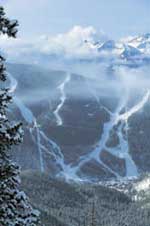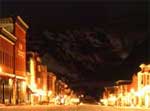 |
||
 |
 |
|

![]()
|
History of Telluride, Colorado Founded in 1878, Telluride has a history as colorful as the twilight alpenglow bathing its Victorian homes. Originally christened Columbia, the fledgling town changed its name in 1887 because of post office confusion with another mining camp named Columbia, this one in California. Thus Telluride began its ascent to the summit of the mining industry. Most say the town is named for the ore of the nonmetallic element tellurium that is found in combination with gold and silver. Others say it is named after a castaway call, "To Hell You Ride," from loved ones who knew of the town's boisterousness. Either way, the young town was full of promise. Lots were as little as $1 in 1881 and houses sprang up, ranging in size from miners' simple wooden shacks to grand Victorian mansions of mine owners. The allure of money and success drifted through Telluride in a palpable wave of greed and desire. The area seemed geographically poised at just the right spot: the southwestern end of the Colorado Mineral Belt, a hearty strip of crustal deformation containing fissures of gold, silver, lead and zinc ore. Indeed, the mines scattered high above the Telluride valley churned out millions of dollars in precious metals. At the apex of the gold rush, nearly 5,000 people inhabited the "Town Without a Bellyache." The famous Tomboy Mine was one of the world's greatest gold producers. There were dances, plays, marching bands and thousands of minds intent on a single communal goal-- prosperity. Prostitutes worked out of rundown houses called cribs on Pacific Street, selling their bodily wares to the work-weary and lonely. Home to tinkling pianos and snapping garters, Popcorn Alley--an aptly named moniker due to the constant opening and closing of doors during the night--was bustling with business until the Silverbell finally shut its doors in 1959. Inevitably, lawlessness was commonplace. Butch Cassidy pulled his first heist in Telluride, robbing the San Miguel Valley Bank in 1889 and lending the town an image of wild notoriety. Despite the patina of success, a vein of discontent began to pulse underneath the bright festivities of Main Street life. Workers at the profitable Smuggler-Union mine, bitter over low wages and back-breaking toil, went on strike. Years of conflict between management and labor followed, pulling Telluride into a gradual decline. The final blow came when the area's mines shut down in 1953. Many left town, and those who stayed sensed the potent energy that had marked the area's heyday had begun to slip through their fingers. For over 20 years, Telluride was an official Colorado ghost town. The million dollar homes of today sold for back taxes and the population dropped into the hundreds. Then the town had its second rush, discovering a mother lode of another sort: white gold. Snow. Once despised by the miners, it falls in glorious abundance on the tops of mountains, collecting pockets of soft powder and clinging to ski trails. It also put Telluride back on the map. The Scandinavian sport of skiing was introduced to Telluride by Swedes and Finns, maybe for the sheer joy, but more for the quick means it provided the eager miners hell-bent on being the first to visit their favorite bordello. It became more of a sport in the 1930s, when the Ski-Hi Ski Club pulled members up a small run on an unsteady rope tow. Nearly 40 years later, an entrepreneur from Beverly Hills, Joe Zoline, happened upon Telluride, finding an opportunity "to do something beautiful and constructive." His vision for a ski area in Telluride resulted in the opening of the first lifts in 1972. Seven years later two Colorado natives, Ron Allred and Jim Wells, picked up where Zoline left off. Today, the population is 1,600 and the pick, shovel and hammer have been replaced by skis, boots and poles. After becoming a joint venture partner in Telluride Ski & Golf in 1999, Morita Investments International has agreed to purchase 100 percent ownership of the ski area. Morita Investments, owned by Hideo Joe Morita, also announced a $14 million investment for a new 733-acre bowl, which will include three detachable quads, buildings, snowmaking and new trails. Jim Wells, co-owner of the resort for 22 years, announced his retirement after six years as president. Johnnie Stevens will assume his duties. Ron Allred, a former owner, will continue as as chairman and CEO. • Alaska • Arizona • California • Colorado • Idaho • Montana • |
||||||||||||||||||||
 |
 |
Email us at info@pacificrimalliance.org
Contents of this site Copyright © 1997-2019 by Pacific Rim Alliance. All rights reserved.
Site designed & maintained by Graphic Dezignz. Last updated October 17, 2017.
 |
 |
Skiing is a Dance in which the Mountain always Leads